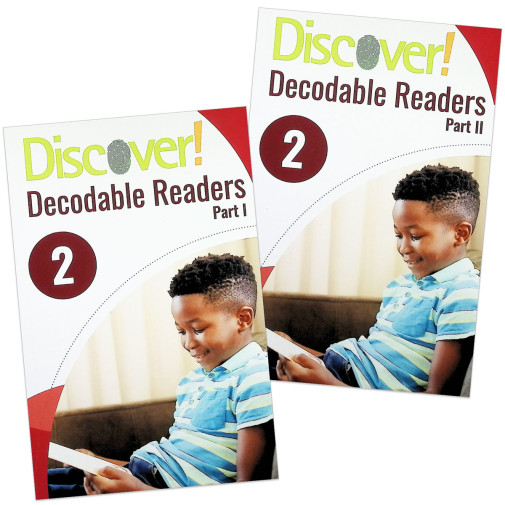We use cookies to make your experience better. To comply with the new e-Privacy directive, we need to ask for your consent to set the cookies. Learn more.
Discover! ELA Decodable Readers - Grade 2 Set
Discover! English Language Arts Grade 2 Decodable Readers (Part 1 and Part 2) are supplemental books that contain short stories written with specific letter-sound patterns. As students read each story, they use their letter-sound knowledge to practice decoding words, phrases, and sentences. At the end of each story, students are asked to practice saying the words, write a word, and learn the meaning of new words. Rubrics are provided to help evaluate students' fluency and comprehension progress. Each reader has 283 pages and measures 8.5” x 5.5”. ~ Amber
As students read each story, they use their letter-sound knowledge to practice decoding words, phrases, and sentences. At the end of each story, students are asked to practice saying the words, write a word, and learn the meaning of new words. Rubrics are provided to help evaluate students' fluency and comprehension progress.
Language arts programs listed in this section cover most areas of language arts (reading/literature, writing, grammar, spelling and handwriting) in one curriculum, although some skill areas may be covered with less intensity than a focused, stand-alone course.
Discover! ELA is designed to encourage and develop independent and critical thinking while also ensuring mastery of foundational skills. As a full English Language Arts option, it is framed in wholesome content that incorporates exploration, direct instruction, skill building, and lesson review. To meet the needs of auditory, visual, and kinesthetic learners, each worktext includes activities, instruction, and extensions. Discover! ELA curriculum covers all essential English Language Arts components for each grade, including spelling and handwriting. Students will learn and practice printing in the younger grades, and cursive handwriting in the upper grades (4th and above).
Each grade set includes a Student Semester A Worktext, Semester B Worktext, a full Instructors Guide, and the Assessment Book. Currently, these are only available as a set and not individually. Decodable readers for Grades 1-2 are sold separately and contain short stories written with specific letter-sound patterns.
Students are set up for success with the lesson goals and objectives in the consumable Student Worktext A & B. Learning is also facilitated by identifying lessons students may need to review, relevant academic vocabulary, and the provision of an optional extension activity. Each course is designed to cover approximately 150 days of instruction. There are approximately 72-75 lessons, with each lesson taking roughly 2-3 days to complete. The curriculum suggests using Day 1 to cover the Explore and Read pages where students will be given a lesson overview and instructions to read the text, write responses, and practice what they learned with graphic organizers, matching, drawing experiments, and hands-on activities. Day 2 covers the Skill Builder and Show What You Know sections, where students will have the opportunity to review and complete assessments aligned with the lesson's objectives. Extension activities are included throughout each lesson and give opportunities to create, make observations, and connect to real-world situations. There are seven chapters, and each chapter ends with review and assessment. The schedule recommendation is to do the Review pages and the first Practice page on the first day and the remaining Practice pages on the second day. Assessments are found in the Instructor Guide as well as the separate Assessment Book. Chapter assessments at all grade levels cover 5-10 lessons. In Grades 1-2 students are asked to complete a project or a task to assess their understanding with an alternative assessment provided that includes true/false, multiple choice, and short answer questions. Assessments in Grades 3-6 provide a more traditional evaluation of mastery with true/false, multiple choice, and short answer questions. There is an alternative assessment included at this level that asks students to complete a project or task to assess their understanding of material. Answers to the Assessments and Grading Rubrics are found in the Instructor’s Guide.
The Instructor Guide takes the guesswork out of lesson planning. It is designed to complement the worktext with suggestions to facilitate, support, and extend students' learning. There are approximately 72-75 lessons in the instructor guide. Each lesson guide lays out the lesson objective, provides answers to the student worktext, and suggests ways to support your student with activities. Learning style options are offered to adapt lessons to auditory, visual, and kinesthetic learners. Assessments in the Instructor Guide are reproducible for family use. Weekly spelling lists are also provided in the back of the instructor guide.
| Product Format: | Other |
|---|---|
| Brand: | Discover! |
| Grade: | 2 |

